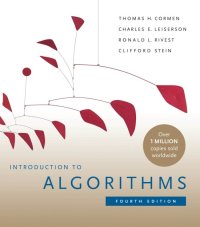
Ebook: Introduction to Algorithms
- Genre: Computers // Algorithms and Data Structures
- Tags: Machine Learning, Algorithms, Data Structures, Number Theory, Dynamic Programming, Graph Algorithms, Hash Functions, Linear Programming, Algorithms Design Techniques, Greedy Algorithms, Divide and Conquer Algorithms, Disjoint Sets ADT, Algorithm Analysis, B-Trees, Algorithm Complexity, Approximation Algorithms, Randomized Algorithms, Sorting Algorithms, Minimum Spanning Trees, NP-Hardness, String Algorithms, Heapsort, Quicksort, Red-Black Trees, Amortized Analysis, Parallel Algorithms, Online Algorithms
- Year: 2022
- Publisher: The MIT Press
- City: Cambridge, MA
- Edition: 4
- Language: English
- pdf
A comprehensive update of the leading algorithms text, with new material on matchings in bipartite graphs, online algorithms, machine learning, and other topics.
Some books on algorithms are rigorous but incomplete; others cover masses of material but lack rigor. Introduction to Algorithms uniquely combines rigor and comprehensiveness. It covers a broad range of algorithms in depth, yet makes their design and analysis accessible to all levels of readers, with self-contained chapters and algorithms in pseudocode. Since the publication of the first edition, Introduction to Algorithms has become the leading algorithms text in universities worldwide as well as the standard reference for professionals. This fourth edition has been updated throughout, with new chapters on matchings in bipartite graphs, online algorithms, and machine learning, and new material on such topics as solving recurrence equations, hash tables, potential functions, and suffix arrays.
Each chapter is relatively self-contained, presenting an algorithm, a design technique, an application area, or a related topic, and can be used as a unit of study. The algorithms are described in English and in a pseudocode designed to be readable by anyone who has done a little programming. The explanations have been kept elementary without sacrificing depth of coverage or mathematical rigor. The fourth edition has 140 new exercises and 22 new problems, and color has been added to improve visual presentations. The writing has been revised throughout, and made clearer, more personal, and gender neutral. The book's website offers supplemental material.
Some books on algorithms are rigorous but incomplete; others cover masses of material but lack rigor. Introduction to Algorithms uniquely combines rigor and comprehensiveness. It covers a broad range of algorithms in depth, yet makes their design and analysis accessible to all levels of readers, with self-contained chapters and algorithms in pseudocode. Since the publication of the first edition, Introduction to Algorithms has become the leading algorithms text in universities worldwide as well as the standard reference for professionals. This fourth edition has been updated throughout, with new chapters on matchings in bipartite graphs, online algorithms, and machine learning, and new material on such topics as solving recurrence equations, hash tables, potential functions, and suffix arrays.
Each chapter is relatively self-contained, presenting an algorithm, a design technique, an application area, or a related topic, and can be used as a unit of study. The algorithms are described in English and in a pseudocode designed to be readable by anyone who has done a little programming. The explanations have been kept elementary without sacrificing depth of coverage or mathematical rigor. The fourth edition has 140 new exercises and 22 new problems, and color has been added to improve visual presentations. The writing has been revised throughout, and made clearer, more personal, and gender neutral. The book's website offers supplemental material.
Download the book Introduction to Algorithms for free or read online
Continue reading on any device:

Last viewed books
Related books
{related-news}
Comments (0)